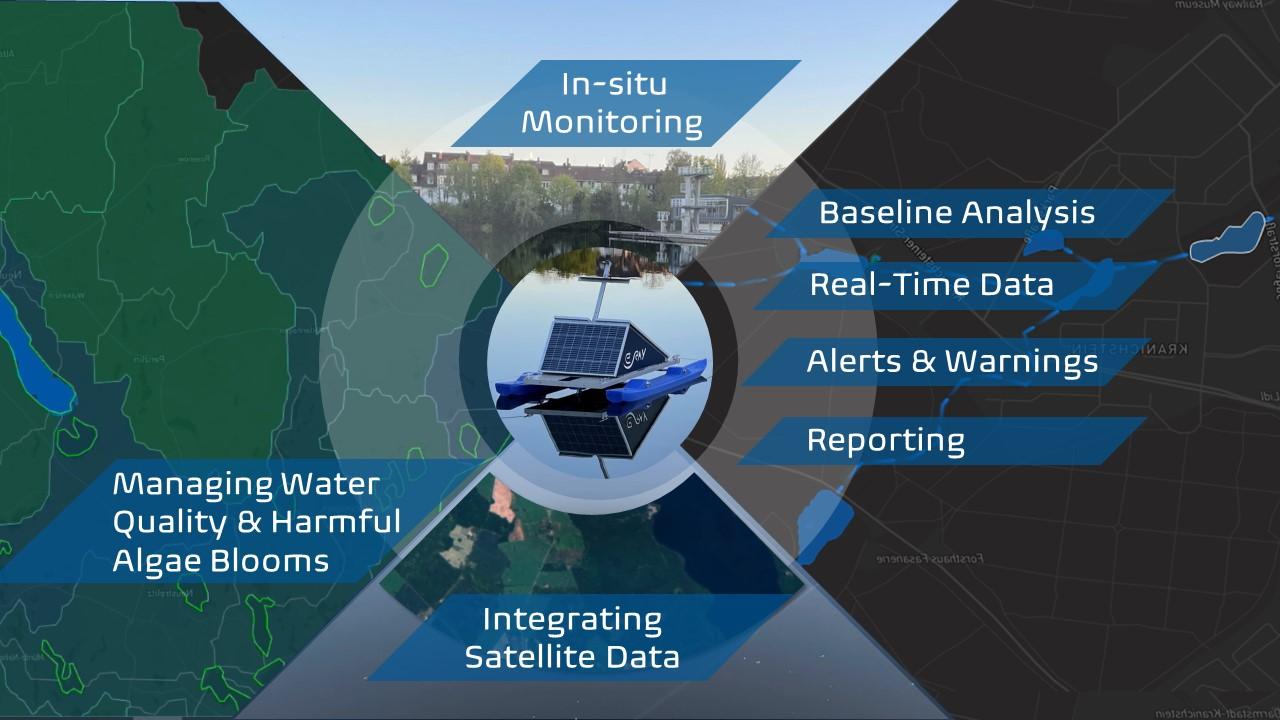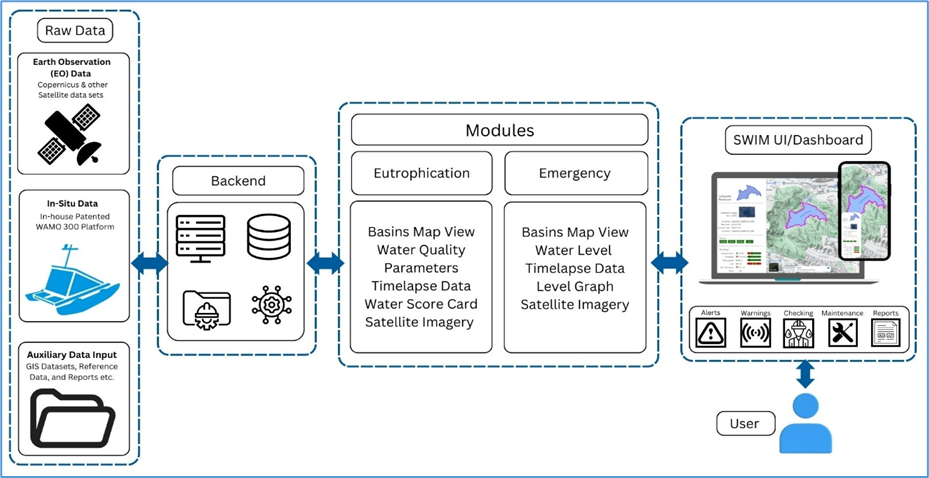
Objectives of the service

Water management today faces significant challenges—inefficient monitoring, delayed detection of harmful algae blooms (HABS), and reactive decision-making that can lead to costly environmental and public health issues. Traditional methods fall short in providing the real-time, actionable data necessary to address these critical HABS problems effectively.
SWIM is the game-changing solution to these challenges. This cutting-edge digital twin platform merges real-time in-situ data, satellite imagery, and advanced analytics to offer unparalleled visibility into water quality. SWIM not only detects harmful algae blooms before they become a crisis but also provides tailored insights, instant alerts, and comprehensive reports that empower both municipal and private sector users to act swiftly and decisively.
Our mission with SWIM is clear: revolutionize water management by equipping users with the tools to anticipate problems, make informed decisions, and optimize the use of water resources. By deploying SWIM, we aim to mitigate risks, protect public health, and ensure sustainable water management for the future.
This is more than a solution—it’s a transformative approach to managing one of our most critical resources in an increasingly unpredictable world.
Users and their needs
SWIM is targeted at government agencies, NGO`s and private sector companies responsible for maintaining water quality. These users are primarily located in countries with strict water quality regulations, where the economic and environmental impacts of issues like harmful algae blooms are significant.
User Needs:
-
Regulatory Compliance: Ensure adherence to stringent water quality standards to avoid penalties and maintain operational licenses.
-
Operational Efficiency: Enhance water management processes to reduce costs and optimize resource utilization.
-
Risk Mitigation: Early detection and proactive management of harmful algae blooms to prevent environmental damage and public health risks.
-
Decision Support: Access actionable insights and comprehensive reports to inform decision-making and strategic planning.
Challenges:
-
Manual Sampling: The current dependence on manual sampling methods is time-consuming, labour-intensive, and often results in delayed or incomplete data.
-
Data Fragmentation: Difficulty in integrating various data sources (e.g., in-situ sensors, lab results) into a unified and actionable format.
-
Tracking and Accountability: Challenges in effectively tracking and evaluating the impact of implemented water management actions, leading to potential inefficiencies and missed opportunities for improvement.
-
Standardization in Reporting: The lack of standardized reporting practices makes it difficult to compare results and ensure consistency across different regions or organizations.
These users of this study are primarily based in European countries, where improving water management practices is essential for both regulatory compliance and operational efficiency.
Service/ system concept
Users receive real-time water quality data for algae monitoring, including parameters like chlorophyll, phycocyanin, pH, turbidity, dissolved oxygen, conductivity, and water temperature at various depths. The system also delivers chlorophyll time-lapse imagery from Sentinel-2 satellites to track algae growth. Tracking these parameters ensures healthy aquatic ecosystems and maintain water quality for safe and effective use.
Key Features and Functionalities:
-
Integrated real-time data from our in-situ WAMO platform and satellite imagery.
-
Baseline diagnostics and historical tracking.
-
Alerts and warnings for harmful algal blooms (HABs).
-
Detailed reporting and data visualization.
User Capabilities When Deployed:
-
Receive real-time alerts for rising HAB risks.
-
Predict early blooms and take preventive action.
-
Make informed decisions based on accurate, up-to-date data.
-
Reduce costs on sampling, infrastructure, and chemical treatments.
-
Track the impact of nature-based solutions on water quality.
SWIM collects water data from three sources: in-situ sensors (WAMO platform), satellite imagery (Sentinel-2), and local datasets (e.g., municipal data). This data is processed and analyzed in real-time, then visualized on a user-friendly dashboard. Users can view map-based data, WAMO data, and time-lapse imagery. If any parameters fall outside of safe ranges, the system automatically triggers alerts.
SWIM Architecture:
-
Data Collection layer: SWIM gathers information from in-situ sensors (WAMO), satellites (Sentinel-2), and local sources.
-
Backend Processing: This data is cleaned and analyzed on SWIM’s servers.
-
Dashboard Visualization: The processed data is then displayed on user-friendly dashboards.
-
Alerts & Warnings: If any data shows potential issues, the system sends alerts to users.
-
User Interaction: Users access the dashboard to view data, receive alerts, and make decisions based on the information provided.

Space Added Value
The SWIM platform's distinctive advantage is rooted in its integration of diverse space assets to enhance water monitoring and management capabilities. Primarily, it utilizes:
-
Earth Observation (EO) Datasets: Leveraging satellite data for comprehensive and continuous surface water monitoring, especially from Copernicus.
-
European Global Navigation Satellite System (EGNSS)-based IoT Platform (WAMO): This provides precise location tracking, enhancing data accuracy for in-situ measurements.
-
Satellite Communication: Vital in disaster scenarios for timely warnings and in areas with poor terrestrial network coverage.
The integration of these space assets offers several added values over traditional methods:
-
Enhanced Accuracy and Reliability: The WAMO OPIE Learning Framework (WOLF) calibrates the data, improving not just the application's precision but also enriching the overall quality of Copernicus's global products.
-
Comprehensive Data Fusion: The combination of EO datasets with EGNSS-based IoT provides a more holistic and robust analysis than what any single source could offer.
-
Real-time Monitoring and Assessment: The platform's ability to continuously gather and process data allows for timely responses to water-related issues, surpassing the capabilities of many existing competitors.
Current Status

SWIM feasibility study has been successfully concluded achieving key milestones, including securing contracts. In Mecklenburg-Vorpommern, Germany, the team won two significant tenders for deploying water quality monitoring systems across 20 water bodies. SWIM are also in advanced discussions with private sector partners for further deployments. The first functional version of the SWIM software, featuring real-time data and Earth Observation integration, has been completed. We are now focused on expanding pilot deployments in Germany and Colombia, incorporating user feedback for system optimization. Additionally, we secured an extension under the European Commission's Horizon Europe program, which will expand SWIM's capabilities to include water quantity and disaster management. Upcoming activities include obtaining regulatory approvals and scaling the technology for broader market deployment. The project is on track for a successful market launch, driven by strong interest from both public and private sector stakeholders.



